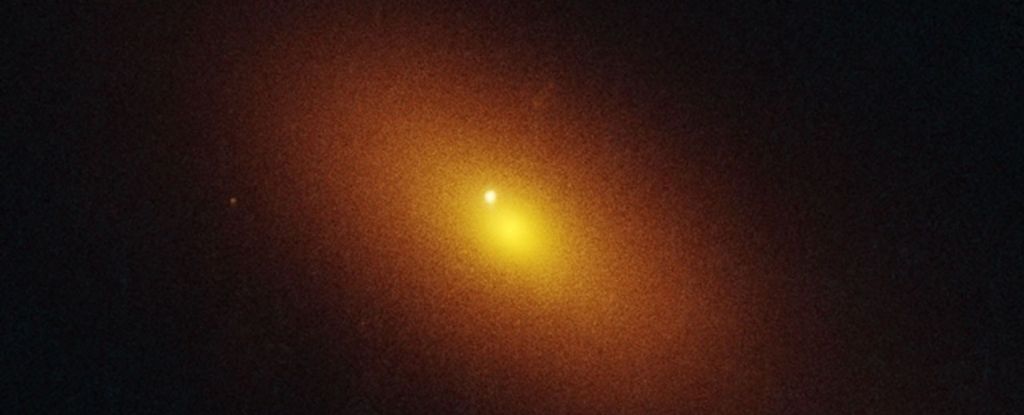Picture a cosmic monster, with the mass of a million suns, drifting silently through the vastness of space, invisible until it devours a star in a dazzling burst of light and energy. In 2025, the Hubble Space Telescope captured evidence of a wandering supermassive black hole in the event AT2024tvd, a phenomenon known as a tidal disruption event (TDE), where a star is torn apart by extreme gravitational forces. This discovery is reshaping what we know about black holes and their relationship with galaxies. What are wandering black holes? How does spaghettification happen? And how does this help us understand the universe? At The Astronomy Insider, we dive into this captivating cosmic mystery and show you how to explore the night sky yourself.
What is a Wandering Black Hole?
Supermassive black holes, with masses millions to billions of times that of the Sun, typically anchor the centers of galaxies, like Sagittarius A* at the heart of the Milky Way. However, AT2024tvd, located 600 million light-years away, revealed a wandering black hole with about 1 million solar masses drifting outside its galaxy’s core. These black holes are rare and hard to detect, only becoming visible when they interact with matter, such as during a tidal disruption event.
Astronomers believe these black holes may be ejected from their original locations due to extreme cosmic events, like galaxy mergers or gravitational interactions with other black holes. The collision of two galaxies, for instance, can “kick out” a supermassive black hole, leaving it to wander through intergalactic space. The discovery of AT2024tvd, announced in May 2025, is the first clear evidence of such a wandering supermassive black hole, captured by Hubble’s precision.
Curious about how the universe created these giants? Read “What is the Big Bang and How It Shaped the Universe” at The Astronomy Insider!
What is a Tidal Disruption Event (TDE)?
A tidal disruption event (TDE) occurs when a star ventures too close to a black hole and is shredded by its gravitational forces. The black hole’s gravity creates a tidal force that stretches the star into a long, thin shape—a process called spaghettification. Some of the star’s material forms a glowing accretion disk around the black hole, while the rest is ejected in high-energy jets. This temporary burst of light, detected in optical and ultraviolet wavelengths, allows astronomers to spot TDEs.
In the case of AT2024tvd, Hubble observed the telltale glow of a star being destroyed, confirming the presence of a black hole outside the galactic core. “Events like this are cosmic beacons, revealing black holes that would otherwise be invisible,” says Ryan Chornock, an astronomer at the University of California, Berkeley. Data from other observatories, including X-ray and radio telescopes, confirmed the event occurred in an unusual region, far from the galaxy’s center.
How Did Hubble Detect AT2024tvd?
The Hubble Space Telescope was pivotal in spotting AT2024tvd due to its ability to capture optical and ultraviolet light with high resolution. The event’s glow, distinct from a supernova, indicated a TDE. Multi-wavelength observations, combining X-ray, radio, and ultraviolet data, confirmed the black hole’s off-center location. This teamwork among telescopes highlights the value of complementary observatories, like the James Webb Space Telescope, which excels in infrared, and Hubble, which shines in visible light.
Why This Discovery Matters
The AT2024tvd event is a milestone in astronomy for several reasons:
- New Galaxy Models: A wandering supermassive black hole suggests galaxy mergers may be more common or complex, challenging theories of galactic evolution.
- Mapping Black Holes: TDEs are one of the few ways to detect wandering black holes, helping map their distribution in the universe.
- Cosmic Impacts: Wandering black holes may influence star formation and interstellar gas dynamics, even outside galactic cores.
- Cosmic History: These events may be remnants of galaxy collisions billions of years ago, connecting us to the universe’s past.
Curious about ancient galaxies? Check out “James Webb in 2025: Cosmic Revelations Redefining the Universe”!
The Future of TDE Research
The AT2024tvd discovery is just the beginning. Observatories like the Vera C. Rubin Observatory, soon to be operational, and the Nancy Grace Roman Space Telescope, set for 2027, may detect more TDEs, identifying other wandering black holes. Computer simulations are also modeling how these black holes move and interact with their cosmic surroundings, offering clues about their origins.
Connect with the Cosmos
Though wandering black holes are millions of light-years away, you can draw inspiration from AT2024tvd and explore the night sky:
- Observe with Apps: Use Stellarium or Sky Tonight to locate galaxies like Andromeda, which may host supermassive black holes. In May 2025, Jupiter is bright, perfect for binocular viewing.
- Follow Celestial Events: Don’t miss the Venus-Jupiter conjunction on August 12, 2025. See “How to Observe Eclipses Safely” for observation tips.
- Track Discoveries: Follow@HUBBLE_spaceor@jameswebb_nasaon Twitter/X for black hole updates.
- Explore with a Telescope: Check out “The Best Telescopes for Amateur Astronomers” to start your stellar journey.
What do you think of this cosmic mystery? Share your thoughts in the comments and subscribe to The Astronomy Insider for more space discoveries!
Sources
- NASA Science. “Webb Sees Galaxy Mysteriously Clearing Fog of Early Universe.” March 26, 2025.
- “Astrônomos Descobrem Buraco Negro Gigantesco Errante.” spacetoday.com.br, May 15, 2025.
- “O Hubble localiza um enorme buraco negro errante.” www.ccvalg.pt, May 13, 2025.
- “NASA descobre buraco negro de grandes proporções no espaço.” www.correiobraziliense.com.br, May 10, 2025.
- “Evento raro revela buraco negro fora do normal devorando estrela.” olhardigital.com.br, May 13, 2025.
- Post on X by @HUBBLE_space, May 15, 2025.
- Post on X by @jameswebb_nasa, May 8, 2025.






No comments:
Post a Comment